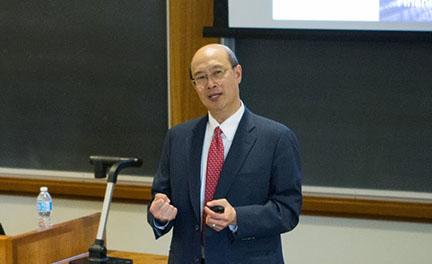MIT Finance Professor is Keynote at Isenberg Conference
May 14, 2014

In his first of two presentations, "Can Financial Engineering Cure Cancer?," Lo made a persuasive case that drug development is becoming increasingly expensive, lengthy, complex, and risky. "The business model of drug development is broken," he emphasized, adding that the needs and expectations of public and private equity and venture capital are increasingly at odds with biomedical innovation.
There is an increasing disconnect, said Lo, between the short-term financial and business priorities of both public and private investors and the lengthy, three-stage horizon of drug development. The scarcity of funding is especially counterproductive between the basic research and human clinical trial phases of the process, he noted.
Unlocking Capital Markets through Financial Engineering
While financial and developmental realities have proved increasingly at odds, the judicious application of financial engineering might save the day, Lo continued. Capital markets have tremendous power. "We need to tap into the tremendous power of capital markets, to channel it," he said. That becomes feasible, he noted, through the deployment of portfolio theory, securitization, and other financial engineering tools.
By investing $30 billion in a portfolio, i.e., a megafund, of 150 independently distributed anti-cancer compounds instead of in just one at a time, you dramatically reduce your risk and increase your likelihood of one or two successes. The reduction in risk allows you to raise the necessary capital by including significant infusions of debt (i.e., bonds) alongside your equity. Lo has run all sorts of simulations that demonstrate the themes and variations of his assertions.
"And with securitization, I can do even better," Lo exulted. That, he said, would allow for the assignment of risk-bearing projects to tranches and the issuance of structured securities, i.e., research backed obligations (RBOs).

While acknowledging the excesses and lack of transparency that led to the 2008 housing bubble and the Great Recession, Lo remarked, "The financial crisis gave me the impetus to think about medical issues the way that I do. . . In that respect, the financial crisis has given us a silver lining."
A Signature Event
Besides a strong turnout from Isenberg, CISDM Research Day attracted members from UMass Amherst's science community, many of whom stayed for Lo's second presentation, "Lies My Finance Professor Told Me: Reconciling Behavioral Finance Via Evolutionary Biology and the Cognitive Neurosciences." Isenberg professors Hossein Kazemi and Bing Liang, CISDM's codirectors, also gave papers. Kazemi explored hedge fund exposures and their implications for performance and herding. Liang examined the relationship between hedge fund ownership and stock market efficiency.
Bing Liang and Hossein Kazemi also presented papers.